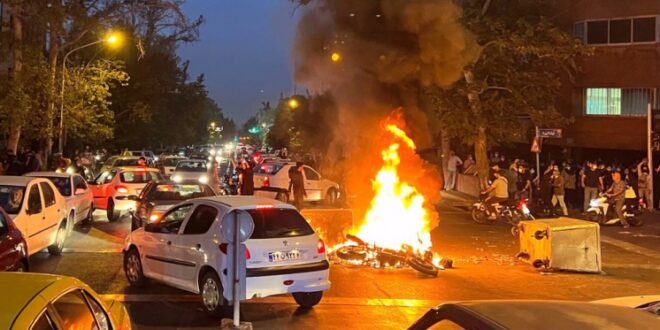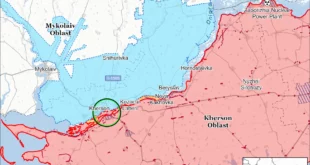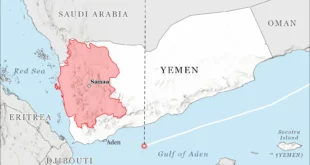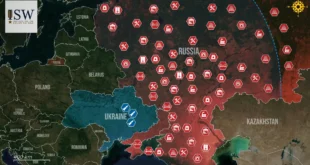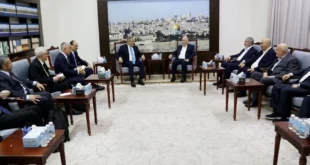Social protest sweeping the country. Economic isolation and a deteriorating security situation in the region. The Islamic Republic of Iran is currently going through one of the most difficult periods in its 44-years old history. Is this the time of the end of clerical rule? Let’s look at the processes that led to the eruption of popular discontent and the current geopolitical environment. What are Iran’s prospects?
On September 13th 2021 in the capital city of Tehran, “morality police” detained a 22- year old woman named Mahsa Amini. Why? She was not covering her hair properly. The hijab has been compulsory in Iran since the Revolution in 1979. Amini was taken to a local police station. Later the same day, in a comatose state, she was taken to a hospital where she died two days later. According to unofficial information, Amini was beaten by the morality police and one of the impacts was aimed at her skull and that’s what led to her death. The official autopsy – confirmed by both sides, pros and cons – says otherwise. It states that she died as a result of the stress [caused by the arrest] since she had a history of brain operations. The voices of sanity agree that was the approximate cause of death.
The young woman’s story – courtesy of the internet – accurate or inaccurate – quickly circulated throughout the country. The day after Amini’s death (September 17th 2021), the first protests took place outside the hospital which began to spread throughout the country in the following days. However, the death of Mahsa Amini was only a pretext [or catalyst] that led to the protests. Indeed, the reasons for social discontent in Iran go much deeper that “moral police” issues.
In 2018, Trump withdrew from the nuclear agreement with Iran that his predecessor, President Barack Obama, had reached in July of 2015. The Trump administration not only reinstated the pre-2015 sanctions but also slapped Iran with multiple packages of new hefty sanctions. As a result, every sector of the Iranian economy came under severe US sanctions. Trump’s administration blatantly pursued a so-called “maximum pressure campaign” towards Iran. The pressure exerted by Trump was so great that – fearing sanctions – even European companies, which has signed lucrative contracts with the Iranians after 2015, withdrew from Iran. Joe Biden, back during his election campaign, announced his willingness to reach a compromise with Iran. At the beginning of 2021, talks began to take place in Vienna on the reactivation of the JCPOA, the acronym for the 2015 Joint Comprehensive Plan of action, i.e. the Iran nuclear agreement. However, despite several rounds of negotiations, an agreement with Iran was not reached. In an interview with Foreign Policy magazine in December 2021, US Special Envoy for Iran, Robert Malley, left no doubt when he stated. “Iran is not interested in a deal and we are focusing on other things.” By that, he probably meant regime change, i.e. Washington’s modus operandi.
However, Iran’s problems are not only related to US sanctions. The Iranian economy suffers from a number of structural problems among which state interventionism definitely stands out in the first place. It is estimated that as much as 40% of Iran’s GDP is produced by entities – directly or indirectly – controlled by the state. These entities mainly include the so-called “Bonyads” (charitable foundations) and companies in which state capital has the upper hand. More often than not, these entities are poorly managed and are responsible for a huge waste of resources and harbor corruption.
The best example of such a state-owned enterprise is the so-called, “Executive Headquarters of Imam’s Directive”, abbreviated as, “SETAD” in Persian. This entity was established in 1989 on the personal orders of Ayatollah Khomeini, the founder of the 1979 revolution. In theory, the SETAD was to, use its powers, make a swift and efficient seizure of assets in the hands of enemies of the Revolution and then redistribute them to various charitable foundations (Bonyads). Once these objectives were fulfilled, the SETAD was to be disbanded. In practice, however, it was quite different. SETAD was never liquidated and over the years, it began to accumulate more and more wealth, buying up stakes in construction companies, banks, oil companies, etc. and gaining enormous influence over the Iranian economy. Today, SETAD’s wealth is estimated at more than $100 billion. At the same time, SETAD remains beyond any control of state factors. The only person who exercises control over it is the Supreme Leader Ayatollah Khamenei.
Parliament, government agencies, or the courts can only intervene in the affairs of the SETAD at the personal request of the supreme leader. The Iranian Revolutionary Guard Corps (IRGC) also has a major influence on the Iranian economy. Among other things, the Corps controls a mega construction company called Khatam al-Anbiya, which including numerous external contractors, employees around 1 million people, and receives billions of dollars in state contracts every year.
Subsequently, the tense social situation in Iran also stems from the crisis of the current formula of governance. Since the 1979 revolution, Iran has remained a theocracy with all institutions under the formal or informal control of the supreme leader, a position held since 1989 by Ayatollah Ali Khamenei. The Iranian system is designed to give Iranians an adjuvant for freedom and democracy – after all the president and members of parliament are directly elected. However, this is only an ancillary for democracy because ultimately the electoral process in Iran is controlled by the elite establishment headed by Ayatollah Ali Khamenei.
The key body in controlling the electoral process in Iran is the Guardian Council. It’s a 12-member body that approves or rejects nominations for president and members of parliament. Six members of the council are directly elected by the Supreme Leader. The other six, on the other hand, are appointed by Parliament on the proposal of the Head of the Judiciary. Importantly, however, the head of the Judiciary is personally elected by the Supreme Leader. As a result, Ayatollah Khamenei has total control over the Guardian Council and can thus block candidates who would threaten his authority. The Supreme Leader’s full control over Iran’s political life is also reinforced by the fact that he personally elects all members of another body called the Expediency Discernment Council. This is a vital body as it resolves any disputes that arise between the parliament and the Guardian Council. Therefore, full control over the Iranian electoral process is in the hands of the so-called “establishment” headed by Ayatollah Ali Khamenei.
Despite this, elections in Iran have so far been a kind of safety valve to calm down tensions in society. Hence, the higher voter turnout is a characteristic of much higher than in Western societies. From the overthrow of the Shah (King) in 1979 until 2019, the average turnout during parliamentary elections in Iran was around 61% and during presidential elections 67%. However, this safety valve has been regularly tightened for several years.
Trump’s denunciation of the JCPOA in 2018 and the return of US sanctions, led the Iranian establishment to turn away from pragmatists like President Rouhani, who wanted to compromise with the US. Instead, the establishment turned to Iranian conservatives, seeing them as the best guardians for the difficult times ahead for Iran In 2020, when Iran held parliamentary elections. The Guardian Council blocked more than half of the nominations. Most of those who got rejected were centrist and moderate politicians. In this way, Supreme Leader Ayatollah Khamenei and the Guardian Council controlled by him – de-facto paved the way for the conservatives to gain power. In the elections, the conservatives won as much as 76% of the vote. However, the set-up was so obvious to voters that turnout was only 42% – the worst electoral results since the overthrow of the Shah in 1979. A year later when presidential elections were held in Iran, the situation repeated itself. The Guardian Council again blocked the candidatures of well-known moderate politicians and secured victory for the conservative candidate, Ebrahim Raisi. However, turnout was again, meager at 48%, which in turn is the worst result in the history of Iranian presidential elections.
One of the pillars of the Islamic Republic of Iran is electoral legitimacy. Since the revolution, elections in Iran, have had two main purposes. On the one hand, they provided the aforementioned safety valve and through the other, they were meant to legitimize the continued existence of the Islamic Republican system. The elections of 2020 and 2021 on the other hand, fulfilled neither of these objectives. In fact, they had the opposite effect. Many Iranians, especially those with more moderate views, felt that their vote did not matter at all, as the results of the election were known even before the vote. This had a devastating effect on public sentiment. It was already bad due to US sanctions and the country’s worsening economic situation. But desperate times requite desperate measures.
Now back to the protests, it is important to know that, as of mid-January 2023, they have been going on for five months, and their dynamics are highly volatile and unpredictable, making it difficult for the security forces to control and put a cap on it. In the first weeks, most of the protests took place on the campuses of Iranian universities and in Iranian Kurdistan, the troubled province where Mahsa Amini was from. By the end of September 2021, however, the center of gravity of the protests had already shifted to Baluchi areas, the impoverished and socio-economically province of Sistan and Baluchistan.
The Baluchi protests, however, had to do not so much with Mahsa Amini’s death as with the rape of a 15-year-old Beluchi girl in the Southwest city of Chahbahar. On December 30th, bloody clashes with police took place in the provincial capital of Zadedan, where at least 40 demonstrators were killed. Some sources say there may have been more casualties, even close to a hundred. The Zahedan casualties had a devastating effect on the situation in the entire province. The Beluchi guerrillas who had been active in the region for years began attacking Iranian security forces in retaliation. The assassination of two members of the IRGC (Iranian Revolutionary Guard Corps) in Zahedan attracted the most attention in the western media. But there were more similar actions. By mid-November, the Iranian authorities managed to bring the situation in the Beluchi areas under control. However, the focus of the protests then shifted again to the Kurdish areas. Huge demonstrations in the Iranian Kurdish cities made the local police lose control of the situation.
Tehran acted sternly. First, on November 14th, IRGC troops fired on targets inside Iraqi Kurdistan. At the same time, a narrative was initiated that the protests taking place in Iranian Kurdistan are supported by renegade Kurdish groups operating on the Iraqi side of the border. While in Baghdad at the time, the commander of the elite Quds Force (IRGC QF) General Esmail Ghaani, reportedly and even threatened the Iraqis with a ground invasion of the Iraqi Kurdistan. A few days later on November 18th, the Corps troops entered the cities of Mahabad, Bukan, Piranshahr, and Sanandaj in the Iranian Kurdistan province. The protesters – at his point criminal secessionists and mercenary anarchists – tried to resist but had little chance against the well-armed and trained Corps troops. This is how the Iranian protests entered a new level: the military pacification of Kurdish towns. The clashes in Baluchistan’s Zahedan and Kurdish towns are reflected in the statistics. Of the approximately 500 demonstrators killed, half were killed in Baluchi and Kurdish provincial areas. The Iranian authorities have an extensive control apparatus at their disposal, Actions against demonstrators/ anarchists are now being taken on many levels.
Above all, access to the internet and the free flow of information is being restricted. If protests occur in a particular place, the police and the so-called Organization for Mobilization of the Oppressed (OMO) popularly known as the “Basij” in Persian, are immediately deployed. The Basij is a massive volunteer organization that is part of the IRGC. The Corps itself is an elite formation, while the Basij is more of a militia. These paramilitary formations, focuses mainly on promoting the ideals of the 1979 Iranian revolution and controlling protests.
Iranian Kurdistan protests show that if the situation gets out of the hands of the local police, additional Basij troops are first directed to fight the demonstrators/ anarchists. If they too cannot manage to break the resistance, then regular Corps troops come in. The Iranian authorities are also fighting the protest at the level of information warfare.
From the very first weeks of the demonstrations, Iranian leaders led by Supreme Leader Ayatollah Khamenei have been trying to blame the protest on America and Israel, accusing these countries of trying to carry out a color revolution in Iran. The authorities are also trying to break up the unity of the demonstrators themselves, according to the old principle of divide and conquer. In September 2021, all morality police, patrols were suspended. For several weeks, the Iranian authorities led by President, have been sending signals that they are prepared to make some concessions to the demonstrators. While there can be no. question of changing the hijab laws, returning to a loose interpretation of them seems realistic. Such a loose interpretation existed, for example, during the presidency of Hassan Rouhani (2013-2021) who criticized the activities of the morality police by stating, “Let people choose their own path to heaven. We cannot send people to heaven by force for the lash.” Such announcements of reforms or looser interpretations of the laws are an attempt to divide protesters and discourage further demonstrations by those who took to the streets for the sake of the hijab alone.
Another tool of control used by the Iranian authorities is mass arrests. Since September 2021, more than 15,000 people have been arrested in Iran for participating in chaos. Judicial proceedings are conducted very quickly and the sentences handed down can be interpreted as harsh. The first death sentences have already appeared and on December 8th, the first execution was carried out.
But the Iranian gubernatorial system is holding firm. For the time being, the clerical establishment does not see the current protests/ anarchies as a direct threat to their power. They seem to believe that the protests are too few in number and too poorly coordinated to be successful. Nonetheless, after five months of protest and the involvement of significant Basij forces and regular Corps troops, the protests have still not been fully controlled and are still ongoing.
An analysis of Iran’s economic political and social situation leads us to conclude that the Islamic Republic is currently going through one of the most difficult periods in its history. This period is all the more difficult because Iran is not facing a single crisis, but several crises at the same time and occurring on different levels.
Since 2018 and the return of US sanctions, Iran’s economic situation has been thorny. The hopes pinned on Joe Biden’s assumption of power in the White House have proved to be misplaced. Instead of the reactivation of the JCPOA, the Biden Administration has brought Iran a de-facto continuation of Trump’s campaign maximum pressure. The pressure that has also led to a massive outflow of European capital from Iran. Tehran is actively seeking alternative trade partners in Moscow, Beijing, Delhi, and some Central Asian countries. From April 20, 2023, Iran will become a full member of the Shanghai Cooperation Organization (SCO), which brings together among others, Russia and China – the two main adversaries of the US.
However, cooperation with “Eastern” countries has its limitations. Russia or China are in no position to provide the modern technology needed, among other things, to modernize Iran’s oil sector. Moreover, even Eastern companies fear US sanctions. In 2019, for example, the Chinese state-owned oil company CNPC withdrew from a $5 billion contract to develop Iran’s South Pars natural gas field which is located under the waters of Persian Gulf.
The international situation in West Asia is also playing to Iran’s disadvantage. Since the conclusion of the so-called Abrahamic Accord and the establishment of diplomatic relations between the United Arab Emirates, Bahrain with Israel, a rapid expansion of cooperation between the Persian Gulf Arab monarchies and Israel is evident. It seems only a matter of time before the Saudis join this emerging geopolitical bloc. Iran fears that the expansion of the Arab-Israeli cooperation will lead to forming a broad anti-Iranian military alliance, which will completely change the balance of power in the region.
The Iranians are also concerned about the situation in the Caucasus. With the Russian military operations involvements in Ukraine, Moscow, for the time being, cannot influence what happens in the Caucasus region. Meanwhile, Azerbaijan and its ally Turkey are adopting an increasingly forceful stance and trying to impose their demands on Armenia. Iran wants to maintain the fragile status-quo by declaring its support for Armenia.
In October of 2021, the IRGC conducted military maneuvers along its border with Azerbaijan, during which they practiced among other things, crossing the River Aras, one of the most intense border regions in the world. At the same time, however, Iran cannot afford to antagonize Turkey too much, which is largely helping Tehran to circumvent US sanctions.
What worries Iranians the most, however, is the lack of prospects for rapid improvement. The economic condition of the country is abysmal, borderline disastrous. Social discontent is growing and the international situation is becoming increasingly dangerous. As if these were not enough, Iranian support for Russian military operations in Ukraine and the supply of the Iranian drones to Russia have made the talks on the reactivation of the JCPOA difficult. The Iranian establishment elite is trying to deal with the situation by increasing the influence of conservative politicians to ensure the Islamic Republic’s survival in difficult times. Time will tell whether such a policy by the Iran’s clerical establishment would secure them another decade of rule.
 Eurasia Press & News
Eurasia Press & News
